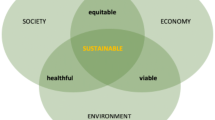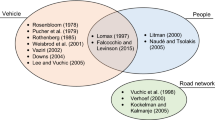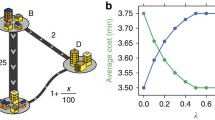Abstract
Traffic congestion is a disruptive fact of urban life. It inflicts delays and frustrations in virtually all major cities in the world, new or old, rich or poor. Although many countermeasures have been tried, it is hard to name a city in which there is much satisfaction with the existing state of affairs. About the only positive aspect of congestion is that it reflects the pulse of life, a demand for travel and trade that typically accompanies economic activity.
Access this chapter
Tax calculation will be finalised at checkout
Purchases are for personal use only
Preview
Unable to display preview. Download preview PDF.
Similar content being viewed by others
Bibliography
Bourne, L. 1989. “Are New Urban Forms Emerging? Empirical Tests for Canadian Urban Areas.” The Canadian Geographer 33:312–328.
Brotchie, J., M. Anderson, and C. McNamara. 1993. Changing Metropolitan Commuting Patterns. Victoria, Australia: CSIRO Division of Building, Construction, and Engineering.
Chinitz, B. 1961. “Contrasts in Agglomeration: New York and Pittsburgh.” American Economic Review, Papers and Proceedings 51(2):279–289.
Chinitz, B. 1991. “A Framework for Speculating about Future Urban Growth Patterns in the US.” Urban Studies 28:939–959.
Dittmar, H. 1993. “Institutional and Political Challenges in Implementing Congestion Pricing: A Case Study of the San Francisco Bay Area.” Paper presented at the National Research Council Symposium on Congestion Pricing, Washington, June.
Downs, A. 1962. “The Law of Peak-Hour Expressway Congestion.” Traffic Quarterly 16:393–409.
Downs, A. 1992. Stuck in Traffic: Co** with Peak-Hour Traffic Congestion. Washington, D.C.: The Brookings Institution.
Earnst and Young. 1992. South Coast Air Quality Management District Regulation XV Cost Survey. Los Angeles: Earnst and Young.
Fielding, G.J. 1987. Managing Public Transit Strategically. San Francisco: Josey-Bass Publishers.
Fielding, G.J., and D.B. Klein. 1993. “High Occupancy/Toll Lanes: Phasing in Congestion Pricing a Lane at a Time.” Reason Foundation Policy Study No. 170. Los Angeles: Reason Foundation.
Giuliano, G. 1989. “New Directions for Understanding Transportation and Land Use.” Environment and Planning A 21:145–159.
Giuliano, G. 1992. “An Assessment of the Political Acceptability of Congestion Pricing.” Transportation 19:335–358.
Giuliano, G. 1993. “Equity and Fairness Considerations of Congestion Pricing.” Paper presented at the National Research Council Symposium on Congestion Pricing, Washington, June.
Giuliano, G., K. Hwang, and M. Wachs. 1993. “Mandatory Trip Reduction in Southern California: First Year Results.” Transportation Research A 27:125–138.
Giuliano, G., and K. Small. 1991. “Subcenters in the Los Angeles Region.” Regional Science and Urban Economics 21:163–182.
Giuliano, G., and R. Teal. 1985. “Privately Provided Commuter Bus Services: Experiences, Problems and Prospects.” In: C. Lave (ed.), Urban Transit: The Private Challenge to Public Transportation, pp. 151–179. San Francisco: Pacific Institute for Public Policy Research.
Giuliano, G., and R. Teal. 1987. “Estimating the Potential Cost Savings of Transit Service Contracting.” Transportation Research Record 1108:1–11.
Giuliano, G., and M. Wachs. 1992a. “Managing Transportation Demand: Markets Versus Mandates.” Policy Insight 148. Los Angeles: The Reason Foundation.
Giuliano, G., and M. Wachs. 1992b. “An Employer Panel for Evaluating the Effectiveness of Trip Reduction Incentives.” Paper presented at the First U.S. Conference on Panels for Transportation Planning, Lake Arrowhead, California.
Gomez-Ibanez, J.A., and K.A. Small. Forthcoming. Road Pricing for Congestion Management: A Survey of International Practice. Syntheses of Highway Practice, National Cooperative Highway Research Program. Washington, D.C.: Transportation Research Board.
Goodwin, P.B. 1990. “How to Make Road Pricing Popular.” Economic Affairs 10 (June/July): 6–7.
Gordon, D. 1991. Steering a New Course: Transportation, Energy and the Environment. Washington, D.C.: Island Press.
Gordon, P., H.W. Richardson, and M.-J. Jun. 1991. “The Commuting Paradox: Evidence from the Top Twenty.” Journal of the American Planning Association 57:416–419.
Hau, T.D. 1992. “Congestion Charging Mechanisms for Roads.” Working Paper No. WPS-1071. Washington, D.C.: The World Bank.
Jones, P. 1991. “Gaining Public Support for Road Pricing through a Package Approach.” Traffic Engineering and Control 32:194–196.
Lave, C. 1991. “Measuring the Decline in Transit Productivity in the U.S.” Transportation Planning and Technology 15:115–124.
Lave, C. 1992a. “Demographic Factors and the Growth of the Automobile Fleet.” Working paper, Department of Economics, University of California, Irvine, March.
Lave, C. 1992b. “Cars and Demographics.” Access 1 (Fall): 4–11. Berkeley: University of California Transportation Center.
Linneman, P., and A. Summers. 1991. “Patterns and Processes of Employment and Population Decentralization in the U.S., 1970–1987”. Paper presented at the Regional Science Association International North American Meeting, New Orleans, November.
Los Angeles County Transportation Commission (LACTC). 1992. Proposed Thirty Year Integrated Transportation Plan. Los Angeles: LACTC.
Lowry, I. 1988. “Planning for Urban Sprawl.” Transportation Research Board Special Report 220:275–312. Washington, D.C.: Transportation Research Board.
Meyer, M.D. 1993. “Alternative Methods for Measuring Congestion Levels.” Paper prepared for the National Research Council Symposium on Congestion Pricing, Washington, June.
Mohring, H. 1979. “The Benefits of Reserved Bus Lanes, Mass Transit Subsidies, and Marginal Cost Pricing in Alleviating Traffic Congestion.” In: P. Mieszkowski and M. Straszheim (eds.), Current Issues in Urban Economics, pp. 165–195. Baltimore: Johns Hopkins University Press.
Moore, J. 1993. “Ridership and Cost on the Long Beach-Los Angeles Blue Line.” Transportation Research A 27:139–152.
Muller, P. 1981. Contemporary Suburban America. Englewood Cliffs, NJ: Prentice-Hall.
Newman, P., and J. Kenworthy. 1988. “The Transport Energy Trade-off: Fuel Efficient Traffic Versus Fuel Efficient Cities.” Transportation Research A 22: 163–174.
Newman, P., and J. Kenworthy. 1992. “Is There a Role for Physical Planners?” Journal of the American Planning Association 58:353–362.
1000 Friends of Oregon. 1992. The LUTRAQ Alternative/Analysis of Alternatives. Interim Report. Portland, Oregon: 1000 Friends of Oregon.
Pickrell, D.H. 1985. “Rising Deficits and the Uses of Transport Subsidies in the United States.” Journal of Transport Economics and Policy 19:281–298.
Pickrell, D.H. 1989. Urban Rail Transit Projects: Forecast Versus Actual Ridership and Costs. Cambridge, Mass.: U.S. Department of Transportation.
Pisarski, A.E. 1992. “Travel Behavior Issues in the 90’s.” Washington, D.C.: U.S. Federal Highway Administration.
Pucher, J. 1988. “Urban Travel Behavior as the Outcome of Public Policy.” Journal of the American Planning Association 54:509–519.
Scott, A.J. 1988. Metropolis: From the Division of Labor to Urban Form. Berkeley: University of California Press.
Shortreed, J., P. May, and E. Dust. 1985. “The Effect of Future Trends on Trip Patterns, Urban Commercial Structure, and Land Use.” Transportation Research Record 1046:50–58.
Shoup, D. 1982. “Cashing Out Free Parking.” Transportation Quarterly 36:351–364.
Shoup, D. 1993. “Cashing Out Employer-Paid Parking: A Precedent for Congestion Pricing?” Paper presented at the National Research Council Symposium on Congestion Pricing, Washington, June.
Small, K.A. 1983. “Bus Priority and Congestion Pricing on Urban Expressways.” In: T.E. Keeler (ed.), Research in Transportation Economics, Vol. 1, pp. 27–74. Greenwich, Connecticut: JAI Press.
Small, K.A. 1992a. Urban Transportation Economics. Chur, Switzerland: Harwood Academic Press.
Small, K.A. 1992b. “Using the Revenues from Congestion Pricing.” Transportation 19:359–381.
Small, K.A. 1993. “Urban Traffic Congestion: A New Approach to the Gordian Knot.” Brookings Review 11(2):6–11.
Southern California Association of Governments. 1993. 1991 Southern California Origin-Destination Survey Summary Findings. Los Angeles: Southern California Association of Governments.
Southworth, F., and F. Westbrook. 1985. Study of Current and Planned High Occupancy Vehicle Lane Use: Performance and Prospects. U.S. Department of Energy Report No. ORNL/TM-9847. Oak Ridge, Tennessee: Oak Ridge National Laboratory.
Tretvik, T. 1992. “The Trondheim Toll Ring: Applied Technology and Public Opinion.” Paper presented at the joint OECD/ECMT/GVF/NFP Conference on The Use of Economic Instruments in Urban Travel Management, Basel, Switzerland, June. Trondheim, Norway: SINTEF Transport Engineering.
Urban Mobility Corporation. 1992. The Miami Jitneys. U.S. Federal Transit Administration Report No. FTA-DC-06-0656-92-1. Washington. D.C.: Urban Mobility Corporation.
Wachs, M. 1993. “Learning from Los Angeles: Transport, Urban Form, and Air Quality.” Transportation 20:329–354.
Webster, F., and P. Bly. 1987. “Changing Patterns of Urban Travel and Implications for Land Use and Transport Strategy.” Transportation Research Record 1125:21–28.
Willson, R.W. 1992. “Estimating the Travel and Parking Demand Effects of Employer-Paid Parking.” Regional Science and Urban Economics 22:133–145.
Editor information
Editors and Affiliations
Rights and permissions
Copyright information
© 1995 Springer-Verlag Berlin · Heidelberg
About this paper
Cite this paper
Giuliano, G., Small, K.A. (1995). Alternative Strategies for Co** with Traffic Congestion. In: Giersch, H. (eds) Urban Agglomeration and Economic Growth. Publications of the Egon-Sohmen-Foundation. Springer, Berlin, Heidelberg. https://doi.org/10.1007/978-3-642-79397-4_9
Download citation
DOI: https://doi.org/10.1007/978-3-642-79397-4_9
Publisher Name: Springer, Berlin, Heidelberg
Print ISBN: 978-3-642-79399-8
Online ISBN: 978-3-642-79397-4
eBook Packages: Springer Book Archive




